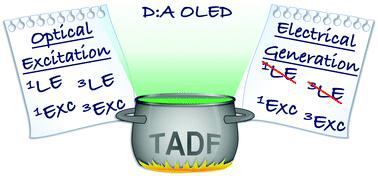当前位置:
X-MOL 学术
›
Mater. Horiz.
›
论文详情
Our official English website, www.x-mol.net, welcomes your
feedback! (Note: you will need to create a separate account there.)
Optically and electrically excited intermediate electronic states in donor:acceptor based OLEDs
Materials Horizons ( IF 12.2 ) Pub Date : 2020-01-06 , DOI: 10.1039/c9mh01475f Nikolai Bunzmann 1, 2, 3, 4 , Sebastian Weissenseel 1, 2, 3, 4 , Liudmila Kudriashova 1, 2, 3, 4 , Jeannine Gruene 1, 2, 3, 4 , Benjamin Krugmann 1, 2, 3, 4 , Juozas Vidas Grazulevicius 5, 6, 7, 8 , Andreas Sperlich 1, 2, 3, 4 , Vladimir Dyakonov 1, 2, 3, 4
Materials Horizons ( IF 12.2 ) Pub Date : 2020-01-06 , DOI: 10.1039/c9mh01475f Nikolai Bunzmann 1, 2, 3, 4 , Sebastian Weissenseel 1, 2, 3, 4 , Liudmila Kudriashova 1, 2, 3, 4 , Jeannine Gruene 1, 2, 3, 4 , Benjamin Krugmann 1, 2, 3, 4 , Juozas Vidas Grazulevicius 5, 6, 7, 8 , Andreas Sperlich 1, 2, 3, 4 , Vladimir Dyakonov 1, 2, 3, 4
Affiliation

|
Thermally activated delayed fluorescence (TADF) emitters consisting of donor and acceptor molecules are potentially highly interesting for electroluminescence (EL) applications. Their strong fluorescence emission is considered to be due to reverse intersystem crossing (RISC), in which energetically close triplet and singlet charge transfer (CT) states, also called exciplex states, are involved. In order to distinguish between different mechanisms and excited states involved, temperature-dependent spin-sensitive measurements on organic light-emitting diodes (OLEDs) and thin films are essential. In our work we apply continuous wave (cw) and time-resolved (tr) photoluminescence (PL) spectroscopy as well as spin-sensitive EL and PL detected magnetic resonance to films and OLED devices made of three different donor:acceptor combinations. Our results clearly show that triplet exciplex states are formed and contribute to delayed fluorescence (DF) via RISC in both electrically driven OLEDs and optically excited films. In the same sample set we also found molecular triplet excitons, which occurred only in PL experiments under optical excitation and for some material systems only at low temperatures. We conclude that in all investigated molecular systems exciplex states formed at the donor:acceptor interface are responsible for TADF in OLEDs with distinct activation energies. Molecular (local) triplet exciton states are also detectable, but only under optical excitation, while they are not found in OLEDs when excited states are generated electrically. We believe that the weakly bound emissive exciplex states and the strongly bound non-emissive molecular triplet excited states coexist in the TADF emitters, and it is imperative to distinguish between optical and electrical generation paths as they may involve different intermediate excited states.
中文翻译:

供体:基于受体的OLED中的光学和电激发中间电子态
由供体和受体分子组成的热激活延迟荧光(TADF)发射器对于电致发光(EL)应用具有潜在的高度吸引力。它们的强荧光发射被认为是由于反向系统间交叉(RISC)所致,其中涉及能量上紧密的三重态和单重态电荷转移(CT)状态,也称为激发态。为了区分不同的机制和所涉及的激发态,对有机发光二极管(OLED)和薄膜进行随温度变化的自旋敏感测量至关重要。在我们的工作中,我们将连续波(cw)和时间分辨(tr)光致发光(PL)光谱以及自旋敏感的EL和PL检测到的磁共振应用于由三种不同的施主:受主组合组成的薄膜和OLED器件。通过电驱动OLED和光激发膜中的RISC。在同一样品集中,我们还发现了分子三重态激子,该激子仅在光激发下的PL实验中发生,某些材料系统仅在低温下发生。我们得出的结论是,在所有研究的分子系统中,在供体:受体界面处形成的激基复合体状态负责具有不同活化能的OLED中的TADF。分子(局部)三重态激子态也是可检测的,但仅在光激发下才可检测到,而在电激发态下,它们在OLED中找不到。我们认为,TADF发射体中弱结合的发射激基复合态和强结合的非发射分子三重态激发态共存,
更新日期:2020-01-06
中文翻译:

供体:基于受体的OLED中的光学和电激发中间电子态
由供体和受体分子组成的热激活延迟荧光(TADF)发射器对于电致发光(EL)应用具有潜在的高度吸引力。它们的强荧光发射被认为是由于反向系统间交叉(RISC)所致,其中涉及能量上紧密的三重态和单重态电荷转移(CT)状态,也称为激发态。为了区分不同的机制和所涉及的激发态,对有机发光二极管(OLED)和薄膜进行随温度变化的自旋敏感测量至关重要。在我们的工作中,我们将连续波(cw)和时间分辨(tr)光致发光(PL)光谱以及自旋敏感的EL和PL检测到的磁共振应用于由三种不同的施主:受主组合组成的薄膜和OLED器件。通过电驱动OLED和光激发膜中的RISC。在同一样品集中,我们还发现了分子三重态激子,该激子仅在光激发下的PL实验中发生,某些材料系统仅在低温下发生。我们得出的结论是,在所有研究的分子系统中,在供体:受体界面处形成的激基复合体状态负责具有不同活化能的OLED中的TADF。分子(局部)三重态激子态也是可检测的,但仅在光激发下才可检测到,而在电激发态下,它们在OLED中找不到。我们认为,TADF发射体中弱结合的发射激基复合态和强结合的非发射分子三重态激发态共存,











































 京公网安备 11010802027423号
京公网安备 11010802027423号